Warsh recitation
The Warsh recitation or Warsh ʽan Naafiʽ' (Arabic: رواية ورش عن نافع) is a Qira'at of Holy Quran in Islam.[1]
| Part of a series on |
| Islam |
|---|
 |
|
Presentation
This recitation of the Quran, known in Arabic as the Qira'at, is conducted according to the rules of Tajwid,[2] in accordance with the Ahruf.[3]
This method is attributed to Imam Warsh who himself obtained it from his teacher Nafiʽ al-Madani who was one of The Seven Readers who transmitted The Ten Readings.[4]
The recitation of Warsh 'an Naafi' is one of the two major traditions of Quranic recitation.[5]
History
This recitation relates to Imam Warsh (110-197 AH), whose real name is Uthman Ibn Sa‘id al-Qutbi, who was born in Egypt.[6]
His nickname Warsh (Arabic: وَرْش), a milk substance, comes from his teacher Nafiʽ al-Madani due to his fair complexion.[7]
He studied his recitation according to Naafiʽ in Medina.[8]
After completing his studies, he returned to Egypt where he became the senior Qāriʾ of the Quran.[9]
In the tenth century, the Muslim scholar Abu Bakr Ibn Mujāhid canonized the seven readings of the Quran, including Warsh ʽan Naafiʽ.[10]
Although having emerged in Egypt, the recitation of Warsh ʽan Naafiʽ has become widespread in North Africa.[11]
In medieval times, it was the main Quranic recitation in Al-Andalus.[12]
The transmission of Warsh ʽan Naafiʽ represents the reciting tradition of Medina.[13]
It is, alongside the Hafs recitation tradition which represents the recitation tradition of Kufa, one of the two main oral transmissions of the Quran in the Muslim world.[14]
Gallery
Warsh recitation with Maghrebi script
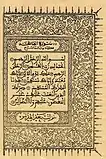
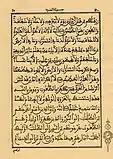 Throne Verse in Thaalibia Mus'haf.
Throne Verse in Thaalibia Mus'haf.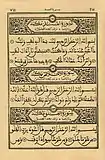 Short Surates in Thaalibia Mus'haf.
Short Surates in Thaalibia Mus'haf.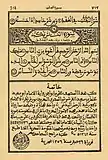 End of Thaalibia Mus'haf.
End of Thaalibia Mus'haf.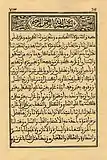 Dua in Thaalibia Mus'haf.
Dua in Thaalibia Mus'haf.
Warsh recitation with Kufic script
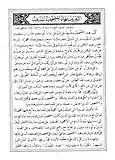 Presentation of Algeria Mus'haf.
Presentation of Algeria Mus'haf.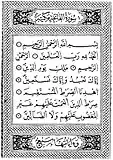 Al-Fatiha in Algeria Mus'haf.
Al-Fatiha in Algeria Mus'haf.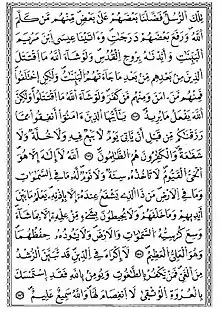 The Throne Verse in Algeria Mus'haf.
The Throne Verse in Algeria Mus'haf. Short Surates in Algeria Mus'haf.
Short Surates in Algeria Mus'haf. End of Algeria Mus'haf.
End of Algeria Mus'haf.
See also
- Qira'at
- Ahruf
- Hizb Rateb
- Salka
- The Ten Readings
- The Seven Readers
- Idjaza
- Special recitations
References
- السمنودي, أبي عبد الله محمد بن حسن/المنير (January 1, 2011). "إتحاف حملة القرآن برواية سيدي ورش عن الإمام نافع من طريق الشاطبية". Dar Al Kotob Al Ilmiyah دار الكتب العلمية – via Google Books.
- "العلوم التجويدية في شرح المقدمة الجزرية soft cover" – via books.google.dz.
- "الزيادة والإحسان في علوم القرآن 1-3 ج2" – via books.google.dz.
- علي, ابن سوار البغدادي/أبو طاهر أحمد بن (January 1, 2010). "المستنير في القراءات العشر". Dar Al Kotob Al Ilmiyah دار الكتب العلمية – via Google Books.
- الجزري, شمس الدين أبي الخير محمد بن محمد/ابن (January 1, 2016). "النشر في القراءات العشر". Dar Al Kotob Al Ilmiyah دار الكتب العلمية – via Google Books.
- القلانسي, أبي العز محمد بن بندار/الواسطي (January 1, 2007). "الكفاية الكبرى في القراءات العشر". Dar Al Kotob Al Ilmiyah دار الكتب العلمية – via Google Books.
- النويري, محمد بن محمد بن محمد بن علي. "شرح طيبة النشر في القراءات العشر - الجزء الأول". ktab INC. – via Google Books.
- الحسن, أبو الكرم الشهرزوري/المبارك بن (January 1, 2008). "المصباح الزاهر في القراءات العشر البواهر 1-2 ج1". Dar Al Kotob Al Ilmiyah دار الكتب العلمية – via Google Books.
- "طيبة النشر في القراءات العشر". IslamKotob – via Google Books.
- "شرح طيبة النشر في القراءات العشر". IslamKotob – via Google Books.
- الواسطي, عبد الله بن عبد المؤمن/ابن الوجيه (January 1, 1998). "الكنز في القراءات العشر". Dar Al Kotob Al Ilmiyah دار الكتب العلمية – via Google Books.
- "الاختلاف الصرفي في القراءات العشر وأثره في اتساع المعاني" – via books.google.dz.
- مهران, أبي بكر أحمد بن الحسين/ابن (January 1, 2018). "الغاية في القراءات العشر". Dar Al Kotob Al Ilmiyah دار الكتب العلمية – via Google Books.
- "المبسوط في القراءات العشر" – via books.google.dz.
